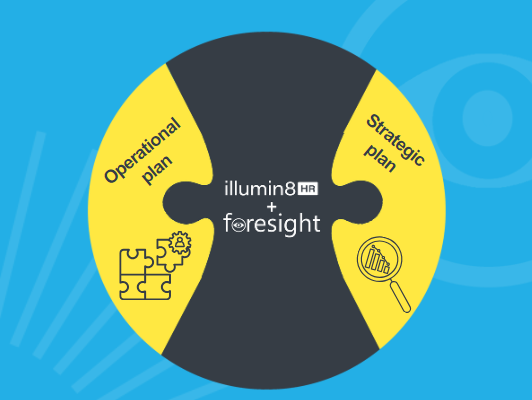What is strategic workforce planning?
According to AIHR, strategic workforce planning is about making sure that the right person is in the right job at the right moment. It requires organisations to analyse current and future workforce trends and assess the skill and competencies needed to support the organisation’s future objectives.
A strategic workforce planning approach is vital to ensure a business has the right staffing levels for both the short and the long term. It involves the adoption of a long-term blueprint typically 2-3 or more years in focus to ensure workforce optimisation that seeks to adopt a holistic strategy encompassing recruiting, developing, managing, retaining and deploying talent to maximise the effectiveness of both the current and future workforce in light of strategic business priorities. (Source: Gartner 2021)
But whilst it’s become an increasingly critical enabler for success, people interpret it in many ways. At our recent leadership forum event one of our expert panellists Oliver Kasper, Head of People Analytics at Richemont Group said: ‘ask 10 people about strategic workforce planning and you will get 12 different answers. For some it may be looking at headcount reporting for the next 3 months, for others it may be looking at what people skills do I need in 10 years’ time to transform my business. Ultimately it comes down to what do you want to achieve and how can startegic workforce planning can help me get there.’
At the Strategic Workforce Planning Conference in London recently, workforce planning experts including Ausra Gabrenaite of Nissan, Martine Mason of Natwest, Tatiana Villalobos of Allianz and Gill Aggus of Jaguar Land Rover shared six key steps to move from a reactive to a truly strategic workforce planning culture.
- Commercial data
Understand what your business priorities and your business objectives are first before you focus on your people. What is it you are trying to achieve? What does the commercial data say about the market – your industry, your competitors, the labour market?
- People data
What are your internal people trends? Retention, retirements, performance, diversity, wellbeing and engagement, salaries, leadership, recruitment? The people trends in your business will massively impact any plans you may have, with lofty ambitions likely to fall flat if data isn’t used to ground them in reality.
- Skills
The big bug bear – with 100s of job titles and often thousands of skills in any one firm, it is often considered a huge task to create an accurate skills taxonomy that allows you to identify the skills you have, the skills you have leaving, the skills you need to replace, the skills you need to train and the new skills you need to acquire.
There is no panacea. However, creating a simpler job architecture of job families and skill grouping as a workable model was suggested as the best way forward. One attendee explained how they slimmed 15,000 skills into 150 job categories and skill groupings which every member of staff was categorised into. It wasn’t perfect, but they were clear that nothing would be, and it allowed them to do the one most important thing: START.
- Measure
Pick a set of meaningful metrics to measure over time. These will be business metrics as well as HR metrics. And tie them back to your HR initiatives to identify and demonstrate the impact your actions have had.
- Start
Push through the resistance. Get stakeholder buy-in by being clear on how adopting a strategic workforce planning approach will benefit each individual in their role and communicating this with them regularly.
Show proof points, not just pain points. Share quick wins, celebrate small steps forward, don’t simply focus on the negatives or the effects of doing nothing.
Engage TA’s and hiring managers early. Talent acquisition teams often bear the brunt of a lack of strategic workforce planning when they are landed with requisitions that need to be filled in 30 days, leaving them no time for planning or adopting a strategic talent acquisition plan. TA teams will see and recognise the benefits.
- Unlock resources
You may need to invest in people analytics tools, as well as workforce planning tools, staff or consultants to get things moving if you don’t already have the skills and resources at hand.
Keep in mind that Senior Leadership Teams often seem to find it easier to sign off on a £3m wage bill than they do for a £50k spend for a new piece of software so understand the ROI. By demonstrating the savings the business could achieve in reducing recruitment costs, time to hire, empty chair time and staff turnover, then tying these savings back to the resourcing budget will enable a more fruitful discussion with the FD and release the necessary funds for your new tool or team member.
Whilst all the above may makes perfect rational sense, unfortunately rationality doesn’t often result in people taking action. We are creatures of habit. We like stability and certainty. Hence only 14% of companies that conduct some sort of workforce planning carry out strategic workforce planning, (Source: Gartner 2021)
Need a trigger? Here’s one.
And If you needed another reason to move to strategic workforce planning there’s a trigger that will be squeezed in about 12 months’ time. That trigger is the EU Pay Transparency Directive.
Due to come into force in 2024, any UK company with operations in Europe with at least 50 employees will be required to publicly report statistical data on the company’s gender pay gap. Many companies will already be reporting their gender pay gap, but this requirement is more stringent than the current UK rules.
Where reporting reveals a gender pay gap of at least 2.5% and the employer cannot justify such difference in average pay level by objective gender-neutral factors, employers will have to carry out a pay assessment in cooperation with workers’ representatives.
Employers may want to take steps now to understand their gender pay gap and start to work towards improving this, or at least justifying it, if they are not doing so already. For companies with pay gaps of over 2.5%, they may consider undertaking pay assessments now and starting to improve their figures so that they have a positive message to provide to candidates and staff.
In any event, the requirement to interrogate your people data, your skills data and measure this in relation to DEI&B (particularly gender) will soon become compulsory for many.
This may just be the trigger you need to marshal the resources and willingness of the board to adopt a strategic workforce planning approach that may just help navigate the challenges ahead.
FREE TRIAL
To have a chat about how you can start collecting and measuring your people data with a free trial of our award-winning people analytics platform: illumin8HR – book a time in my diary here:




